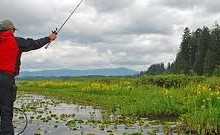Flipping or Punching for Bass
Posted by Sam Law (2/22/2023)

Flipping or Punching is a technique used in bass fishing that involves using a heavy rod and reel, a short line, and a heavy weight to make accurate and precise casts into heavy cover or structure, such as weed beds, brush piles, or fallen trees, where bass are likely to be hiding.
Here are the basic steps for flipping:
Select the right gear: To flip effectively, you'll need a heavy rod (usually 7 to 8 feet in length) with a fast action and a heavy power rating, a baitcasting reel with a strong drag system, and a heavy line (usually 15 to 20 pound test, or 50-65 pound braided line) to handle the weight of the lure and pull the fish out under heavy cover.
Rig your bait: For flipping, a Texas-rigged soft plastic bait, such as a worm or a creature bait, is often used. The bait is rigged weedless, with the hook point buried in the plastic, to avoid getting snagged on cover.
Make accurate casts: Flipping requires accurate and precise casts to specific targets. The bait is usually dropped into the water with a short pitch or underhand cast, rather than a traditional overhand cast.
Work the bait: Once the bait is in the water, it's important to work it slowly and methodically, often with small hops or twitches, to mimic the movement of prey and to entice a strike.
Set the hook: When a bass strikes, it's important to set the hook quickly and firmly, using a strong hookset with the heavy gear.
Flipping can be a very effective technique for targeting bass in heavy cover and structure, where other techniques may not be as effective. It requires patience, accuracy, and a willingness to get close to cover, but can result in some very rewarding catches.
Liked this article? Share it:


